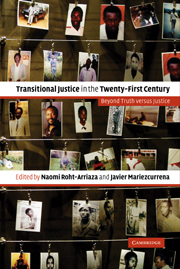Book contents
- Frontmatter
- Contents
- List of contributors
- Acknowledgments
- The new landscape of transitional justice
- Part I Truth, justice, and multiple institutions
- Part II Levels of justice: Local, national and international
- Introduction to Part II
- 7 A new approach to restorative justice – East Timor's Community Reconciliation Processes
- 8 Justice at the grassroots? Gacaca trials in Rwanda
- 9 Bremer's “Gordian Knot”: Transitional justice and the US occupation of Iraq
- 10 Truth, justice and stability in Afghanistan
- 11 The prosecution of Hissène Habré: International accountability, national impunity
- 12 Argentina's contribution to global trends in transitional justice
- 13 Transitional justice: Lessons learned and the road ahead
- Index
12 - Argentina's contribution to global trends in transitional justice
Published online by Cambridge University Press: 05 June 2012
- Frontmatter
- Contents
- List of contributors
- Acknowledgments
- The new landscape of transitional justice
- Part I Truth, justice, and multiple institutions
- Part II Levels of justice: Local, national and international
- Introduction to Part II
- 7 A new approach to restorative justice – East Timor's Community Reconciliation Processes
- 8 Justice at the grassroots? Gacaca trials in Rwanda
- 9 Bremer's “Gordian Knot”: Transitional justice and the US occupation of Iraq
- 10 Truth, justice and stability in Afghanistan
- 11 The prosecution of Hissène Habré: International accountability, national impunity
- 12 Argentina's contribution to global trends in transitional justice
- 13 Transitional justice: Lessons learned and the road ahead
- Index
Summary
Introduction
In order to understand the diverse transitional justice mechanisms discussed in this book, we need to look at developments at the international and regional level as well as within individual countries. The doctrine of complementarity built into the statute of the International Criminal Court can be seen as a metaphor for a much broader form of interaction of the international and domestic legal and political spheres in the area of transitional justice. Developments at the international level depend upon processes at the domestic level, and vice versa.
In addition to discussing the case of Argentina, we will also sketch out some broad international and regional trends in the area of transitional justice. These trends make clear that dramatic changes have occurred in the world with regard to accountability for past human rights abuses. This trend is what Lutz and Sikkink have called “The Justice Cascade” – a rapid shift towards new norms and practices of providing more accountability for human rights violations. The case of Argentina is particularly interesting because far from being a passive participant in or recipient of this justice cascade, Argentina was very often an instigator of particular new mechanisms within the cascade. The case illustrates the potential for global human rights protagonism at the periphery of the system. The Argentine case also supports the general thesis of the volume that multiple transitional justice mechanisms are frequently used in a single case.
- Type
- Chapter
- Information
- Transitional Justice in the Twenty-First CenturyBeyond Truth versus Justice, pp. 301 - 324Publisher: Cambridge University PressPrint publication year: 2006
- 27
- Cited by

